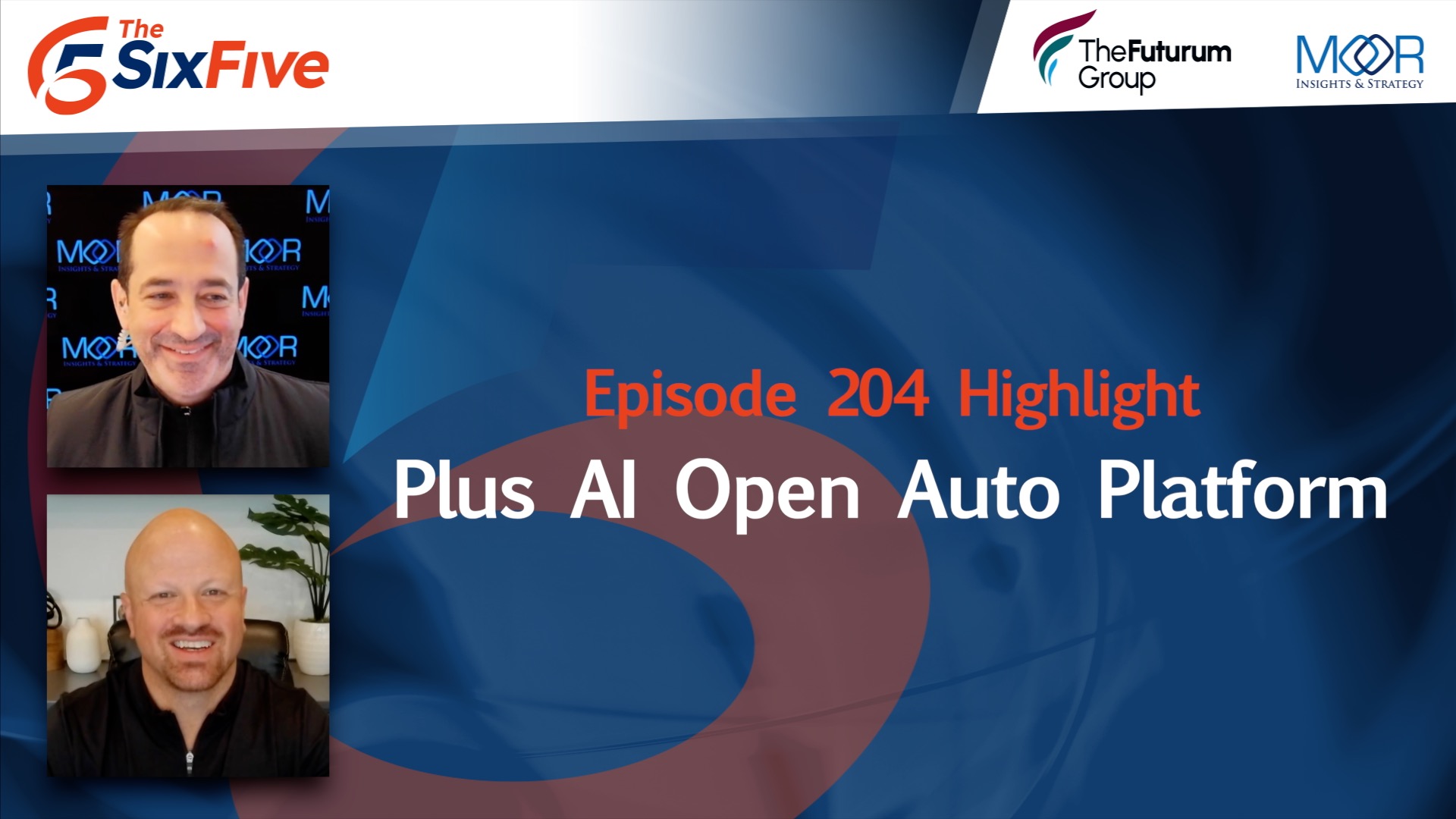The Six Five team discusses Plus AI Open Auto Platform.
If you are interested in watching the full episode you can check it out here.
Disclaimer: The Six Five Webcast is for information and entertainment purposes only. Over the course of this webcast, we may talk about companies that are publicly traded and we may even reference that fact and their equity share price, but please do not take anything that we say as a recommendation about what you should do with your investment dollars. We are not investment advisors and we ask that you do not treat us as such.
Transcript:
Patrick Moorhead: And guess what, we’re going to talk more AI. Dan, it’s just all about AI at this point, isn’t it? So Plus is a platform provider, hardware and software for autonomous driving. You’re like, “Well, wait a second, we never quite heard of them before.” Well, that’s one of the reasons we’re bringing this to light. They are actually the market leader in autonomous trucking. Now, their software is very applicable to passenger cars as well. You would think… How many tons is a big truck, Dan, fully loaded–
Daniel Newman: I should know this. I don’t know this, though.
Patrick Moorhead: Anyways, it’s tens of tons, likely, probably more, because a car is only two tons. But anyways, it is, in many ways, if you can get it right for trucking, it seems like you could get it right for passenger vehicles. They cut deals, big deals with big trucking companies of Echo, retailers and things like that. But anyways, the big announcement that they had is they are going to now sell their software in modules. So they are splitting up the bundle. So if you are a tier one or an automaker and you just want, let’s say, AV functional module, or an off-board module, or a vehicle integration module, you can grab those. And then what you do, right, you connect the sensors, the actuation, computing platform, then you can integrate that all together, if you’re an OEM.
I view this move as very customer-centric. I’m very interested to see, like right now they’re on the NVIDIA computing platform. I think they will have to move in the direction where they’re compatible with Qualcomm. They’re compatible with Intel. And by the way, check out Intel just threw their hat back in the ring, not to be confused with Mobileye. Read the white paper on our website if you want more on that. And obviously, AMD has aspirations as well. And by the way, Intel would be an interesting partner, because if you remember our interview with Jack Wiest, he talked about wanting to collaborate with other ADAS software suppliers. It almost seems like a perfect combination. So there were no customers listed in the press release. I had the chance to talk with Plus CEO, David Liu, on it, and I’m going to be doing a write-up shortly, but I love it, man. Customer centricity, baby. “You want modules? We will give you modules.”
Daniel Newman: Yeah, I mean, Pat, look, you and I have both been pretty bullish on the Snapdragon platform for auto. And the reason was really the digital chassis has been all about kind of building blocks. So the original thesis of Plus was a little bit more of these kinds of complete systems, turnkey. It was really twofold. It was either kind of the augmented vehicle of “truck of today” or it was this net new future vehicle, but it was going to be ground-up built on their platform. Now they’re basically saying, “Look, we’ve got building blocks that you can put into use, and we’re going to license and sell.”
And I didn’t have the conversation you had, so I’m working off the press release. But the bottom line is I think they needed to open this up to create a bigger tamp. It’s more market. It’s an opportunity to diversify who they sell to, and take the IP that they’ve been working to build, and make it available to a broader set of customers. They’ve been out there for a while now. You and I have actually ridden in these trucks. We’ve experienced the Plus truck in San Jose. We actually drove around. And so we know what they’re doing. We know that they’re innovating. But I think the modularity gives them more flexibility in their go-to market. And I think right now that’s what they need.
For me, it’s early to see, Pat, to your point, I’d like to hear more about wins. I’d like to hear more about who’s buying this and what sort of drove this. But it’s early days. So this one’s a light one for me. I don’t have a lot to add here, Pat, but I do like to see the company continue to grow and scale. I’ve enjoyed the interactions we’ve had with David. I look forward to reading your write up.
Author Information
Daniel is the CEO of The Futurum Group. Living his life at the intersection of people and technology, Daniel works with the world’s largest technology brands exploring Digital Transformation and how it is influencing the enterprise.
From the leading edge of AI to global technology policy, Daniel makes the connections between business, people and tech that are required for companies to benefit most from their technology investments. Daniel is a top 5 globally ranked industry analyst and his ideas are regularly cited or shared in television appearances by CNBC, Bloomberg, Wall Street Journal and hundreds of other sites around the world.
A 7x Best-Selling Author including his most recent book “Human/Machine.” Daniel is also a Forbes and MarketWatch (Dow Jones) contributor.
An MBA and Former Graduate Adjunct Faculty, Daniel is an Austin Texas transplant after 40 years in Chicago. His speaking takes him around the world each year as he shares his vision of the role technology will play in our future.







